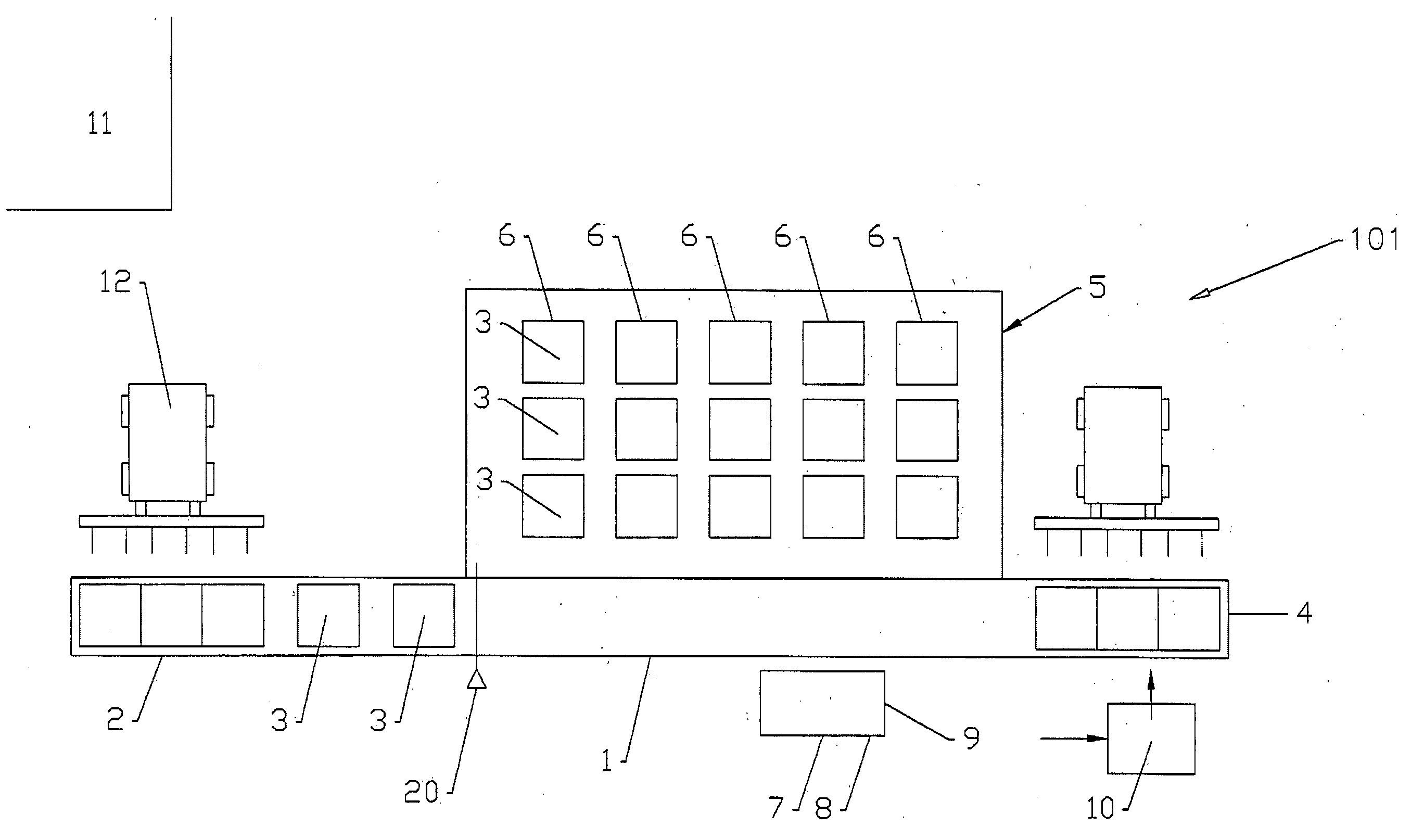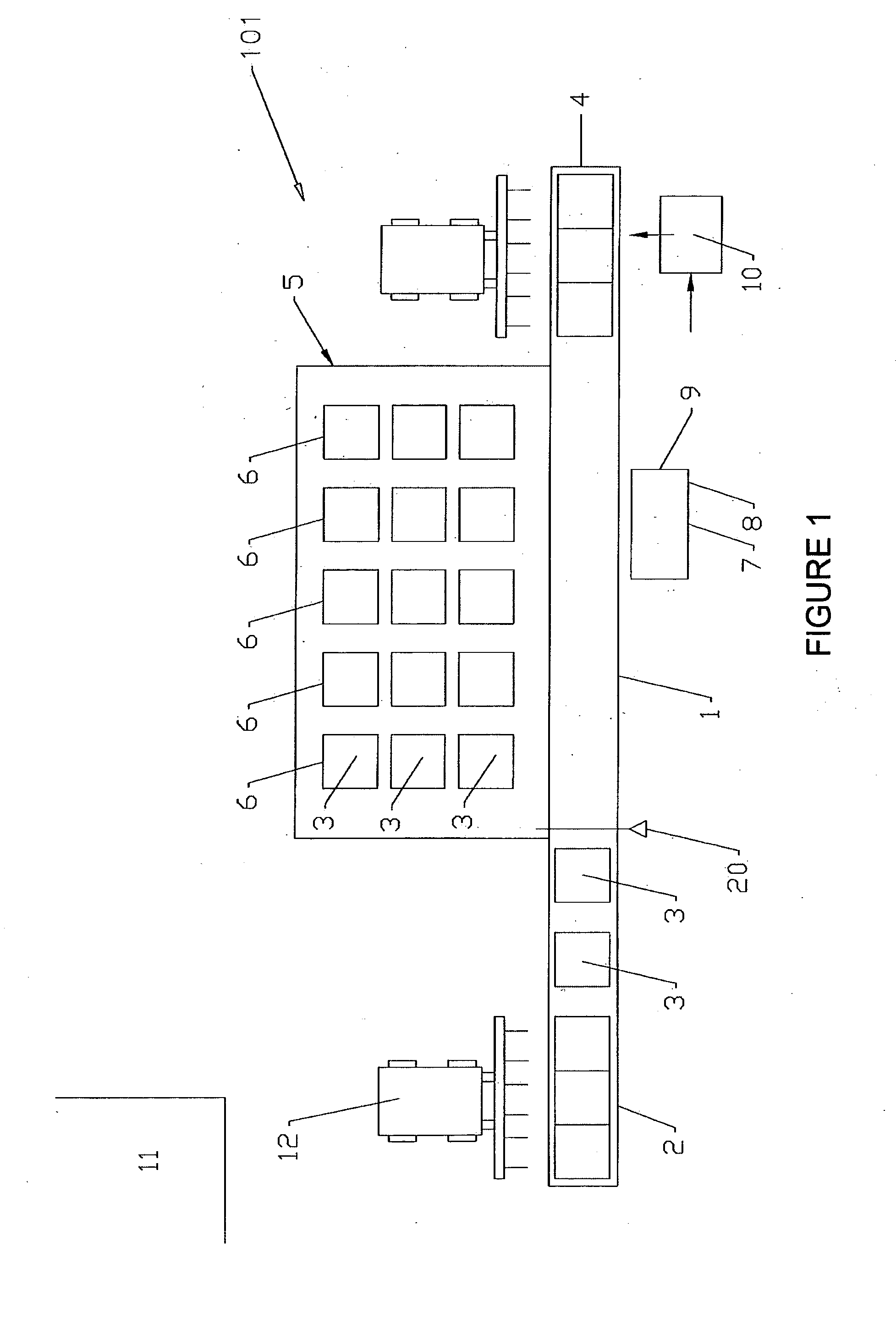Container storage and retrieval system and method
a storage and retrieval system and container technology, applied in the field of container storage and retrieval system and method, can solve the problems of inefficiency and/or impracticality, inefficient use of space, and minimise distance, and achieve the effect of efficient use of available footprint and quick storage and retrieval of products
- Summary
- Abstract
- Description
- Claims
- Application Information
AI Technical Summary
Benefits of technology
Problems solved by technology
Method used
Image
Examples
second embodiment
[0137]In the example shown in FIG. 1, the stacks 3 in the container store 5 are stored in a static manner, that is, once the stacks 3 have been placed into the container store 5 they remain stationary until moved by the container retrieval means 8. However, as is described below with reference to FIGS. 2 to 4, in the system the container store 5 includes means for moving the stacks 3 in the rows 6 along the row 6 towards or away from the first conveying means 1, without the use of the loading means 7 or retrieving means 8.
[0138]Referring back to FIG. 1, a control means 10, for example a computer, controls the operation of the conveyor 1 and the container loading and retrieving means 9. The system 101 may be operated in a number of ways to provide a required number of containers 3 to the discharge position 4 of the main conveyor 1.
first embodiment
[0139]In the system 101 the control means 10 receives an order for a required number Nx of containers containing a certain item X, and a required number Ny of containers of a different item Y. If both Nx and Ny are equal to or divisible by the number of containers in a frame of containers then the control system sends a signal which is interpreted as a request for the requisite number of whole frames of each product to be loaded from a bulk storage area 11 (only a portion of which is shown in the Figures) onto the loading position 2 of the first conveying means 1, for example by a forklift. The signal may be any suitable signal, for example some sort of electronic display. The first conveying means 1 then moves the frame of containers to the discharge position 4 where the containers are collected and dispatched. In an alternative embodiment the control system may direct that the frame be dispatched directly from the bulk storage area 11, bypassing the first conveying means 1, or a s...
embodiment 106
[0166]Referring next to FIG. 10, another system 108 is shown. In this system the container store 5, first conveying means 1, container store delivery conveyor 26 and container store dispatch conveyor 28 are arranged substantially as described above with reference to the embodiment 106 shown in FIG. 8, except the container store dispatch conveyor 28 is closer to the loading position 2 of the first conveying means 1 than the container store delivery conveyor 26 is.
[0167]A stacking / destacking means 30 is provided, either adjacent the intersection of the container store dispatch conveyor 28 and the first conveying means 1, or over or adjacent the first conveying means 1 between the container store dispatch conveyor 28 and the container store delivery conveyor 26.
[0168]The stacking / destacking means 30 is adapted to destack full stacks into at least two partial stacks, and to create a single stack by stacking two or more partial stacks, as required. The operation of the destacking means w...
PUM
 Login to View More
Login to View More Abstract
Description
Claims
Application Information
 Login to View More
Login to View More - R&D
- Intellectual Property
- Life Sciences
- Materials
- Tech Scout
- Unparalleled Data Quality
- Higher Quality Content
- 60% Fewer Hallucinations
Browse by: Latest US Patents, China's latest patents, Technical Efficacy Thesaurus, Application Domain, Technology Topic, Popular Technical Reports.
© 2025 PatSnap. All rights reserved.Legal|Privacy policy|Modern Slavery Act Transparency Statement|Sitemap|About US| Contact US: help@patsnap.com



